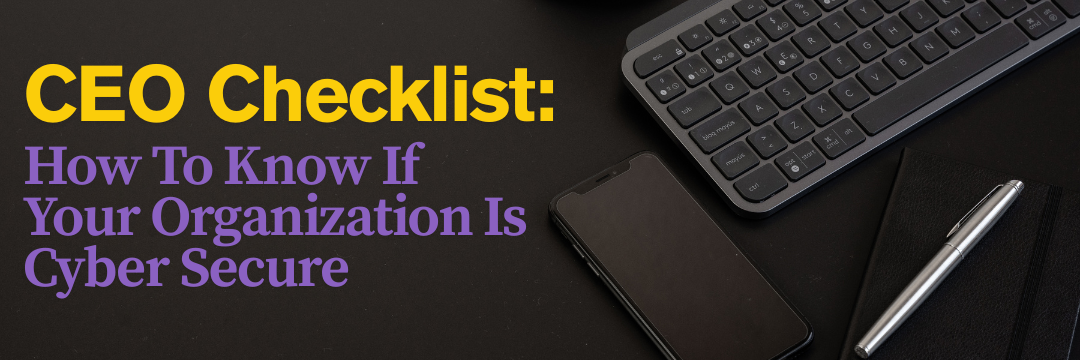CEO Checklist: How To Know If Your Organization Is Cyber Secure
By Akash Desai, Director, ERMProtect IT Security Consulting
Hackers make headlines and CEOs have headaches.
CEOs today understand how cybersecurity is not just a technical issue anymore and how it can greatly impact reputation, operations, and even business survival.
As a CEO it can feel like you’re leaping in the dark while relying on updates from your technical team that are full of esoteric jargon or assurances from your vendors who tell you that everything is shipshape.
This CEO checklist is designed to change that. It’s not a deep technical audit – it’s just a set of straight-to-the-point questions any CEO should be asking to get a real-world pulse on whether the organization is secure and compliant.
Think of it as a starting point for executive oversight, helping you spot gaps, test what your team is telling you, and prioritize where to invest attention or budget.
Leadership & Accountability
1. Is there a single individual who is accountable for cybersecurity in my organization? Do they report directly to me or the board?
Why it matters: Clear accountability is important. Without a specific individual who owns the cybersecurity function of your organization – and has the authority and visibility to act – you’re likely to see gaps between intention and execution. Reporting lines also matter. Your cybersecurity leader needs direct access to decision-makers, not just IT managers.
2. Did we test our incident response plan in the past year? Did this incident response plan test involve the full executive team?
Why it matters: Having a plan on paper isn’t enough. How do you know it’s going to work when a real-world incident strikes? Regular tabletop exercises – especially those involving senior leadership – help reveal where processes break down under pressure. Also, technical incident response plan tests with red and blue teams simulating live attack and defense are another important way to test your plan well.
3. Do I receive regular, strategic cybersecurity updates that inform business decisions?
Why it matters: Cyber risk is business risk. As CEO, a pile of exported printouts with the latest patch names installed will not help you. You’ll need contextual insights: what threats are rising, what assets are exposed, what’s changing in the regulatory landscape. These updates should influence budgets, hiring, and overall strategy.
Risk Management & Compliance
4. Are we fully compliant with all relevant and applicable cybersecurity regulations? Who verifies this compliance?
Why it matters: Fines, lawsuits, and reputational damage often follow non-compliance – even without a breach. Having a third-party validate compliance ensures you’re not just self-certifying based on outdated assumptions or internal biases. You shouldn’t be grading your own test.
5. Have we engaged a third-party to perform a risk assessment or IT audit in the past year to obtain an unbiased view?
Why it matters: Internal teams often have blind spots – or incentives to downplay risk. Independent audits bring…well…independence, and credibility. At ERMProtect, we’ve uncovered expired firewall rules, dormant user accounts, and unencrypted systems in companies that thought they were “fine”.
6. Do we have cyber insurance? What does it cover, and are there any notable exclusions?
Why it matters: Not all cyber policies are created equal. Many exclude critical incidents (like nation-state attacks or employee errors), and some require specific security measures to be in place, or the claim is denied. Know the fine print – and be sure your controls match the requirements.
7. Have we identified, inventoried (formally documented), and prioritized our most critical digital assets and data?
Why it matters: You can’t protect what you don’t know you have. Without an up-to-date asset inventory and data map, your security efforts may be protecting the wrong things or the incomplete picture, while truly critical data is being left exposed inadvertently.
People & Processes
8. Have all our employees taken security awareness training during the past year? Do the results of our social engineering assessments attest to its effectiveness?
Why it matters: Humans are still the weakest link. Training is only useful if it actually changes behavior, which is why simulated phishing tests and other social engineering assessments are essential. If people fail those tests, the training isn’t working.
9. Do we have a secure process to promptly revoke access for departing employees or vendors?
Why it matters: Dormant accounts are an open invitation for hackers, or even disgruntled insiders. Timely and consistent offboarding procedures are low-effort high-impact security measures.
10. Do we have measures in place to detect and prevent insider threats?
Why it matters: Not every threat comes from outside. Insider threats, both malicious and accidental, are responsible for a significant percentage of breaches. Monitoring for unusual access patterns, enforcing least privilege, and having an internal reporting mechanism can make all the difference.
11. Do we have formally documented policies and procedures, incident response plan, and business continuity plan?
Why it matters: When chaos hits, you don’t want people making it up as they go. Well-documented, regularly updated (and tested!) plans ensure everyone knows their exact role and that nothing mission-critical is forgotten under stress.
Technology & Resilience
12. Did we perform penetration test on all our technical infrastructure during the past year? Were any vulnerabilities detected that were previously marked as resolved by my team?
Why it matters: Pen tests don’t just find vulnerabilities – they test your team’s assumptions. We’ve seen cases where patches were marked “complete” but never applied, or where old systems were thought decommissioned but were still exposed.
13. Do we have real-time monitoring for unauthorized access or data exfiltration?
Why it matters: Detection is just as important as prevention. The sooner you know something’s wrong, the faster you can respond. Without this visibility, attackers can linger undetected for months extracting sensitive data at will. In fact, you may have heard the phrase “Advanced Persistent Threat”. That’s what that is.
14. Is our security infrastructure cohesive, or are we relying on a fragmented set of tools?
Why it matters: A patchwork of vendors and tools can lead to coverage gaps, integration failures, and alert fatigue. Unified platforms (or well-integrated toolsets) give clearer visibility, faster response times, and better ROI.
15. In the event of a ransomware attack today, could we restore operations fully without paying a ransom?
Why it matters: Backups only help if they’re recent, tested, and isolated from the attack. If you can’t restore quickly, you're at the mercy of attackers and may end up paying even if you have cyber insurance.
CEO Checklist: How Did You Do?
- 13–15 Yes Answers: Strong cybersecurity posture. Keep up the good work.
- 9–12 Yes Answers: Moderate risk. Bridge the gaps so that you’re on track.
- 5–8 Yes Answers: Significant vulnerabilities. Immediate action required.
- Fewer than 5 Yes Answers: High risk. Big changes needed.
ERMProtect is the CEO Ally
Protecting your organization and its assets is amongst the most critical responsibilities of a CEO, so hopefully you found this CEO checklist helpful. At ERMProtect, we take pride in our relationship to our CEOs in 40+ industry verticals.
For nearly three decades, our team has offered our expertise, experience, and commitment to safeguard our clients’ cybersecurity posture. For more information, please email Judy Miller at [email protected] or call 305-447-6750.
About the Author
Akash Desai is a Director of Consulting for ERMProtect. For more than 21 years, he has combined technical expertise with creativity and problem-solving acumen to create innovations and solutions that address challenging cybersecurity problems. His past accomplishments at the prestigious CERT® Coordination Center and the innovative Carnegie Mellon CyLab bear witness to his goal-oriented approach to cybersecurity’s biggest issues in the areas of insider threat, intrusion prevention, proactive and agile cyber-defense, and security awareness training. At ERMProtect, he is the brain behind the innovative ERMProtect cybersecurity awareness training practice and he has led several, highly complex cybersecurity projects and project teams.
Subscribe to Our Weekly Newsletter
Intelligence and Insights

Are You Prepared for an AI-Powered Cyber Attack?

AI Privacy Risks




